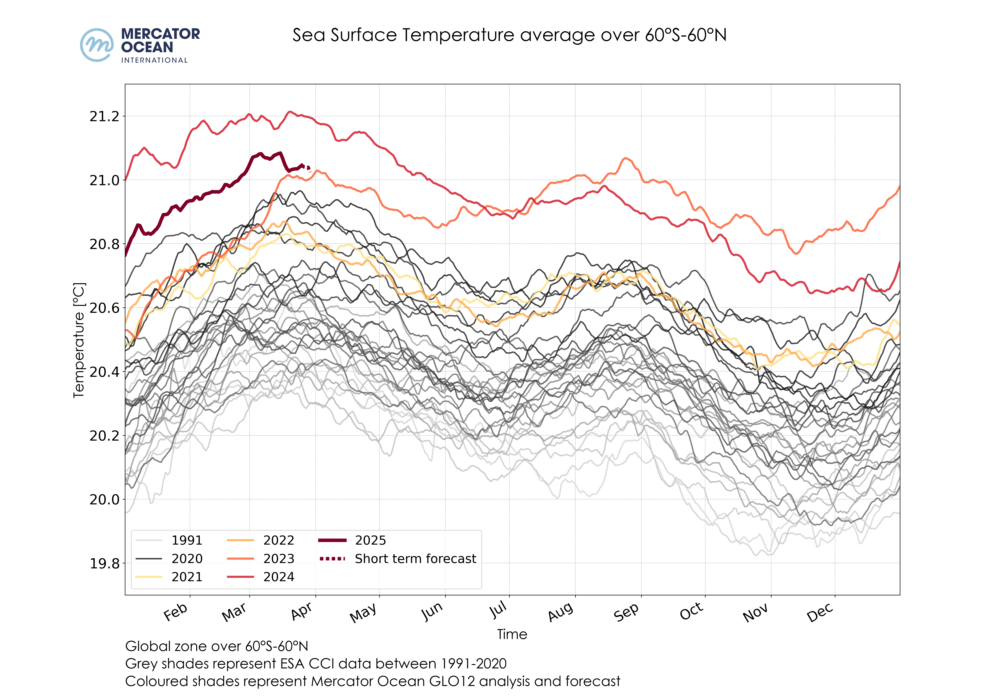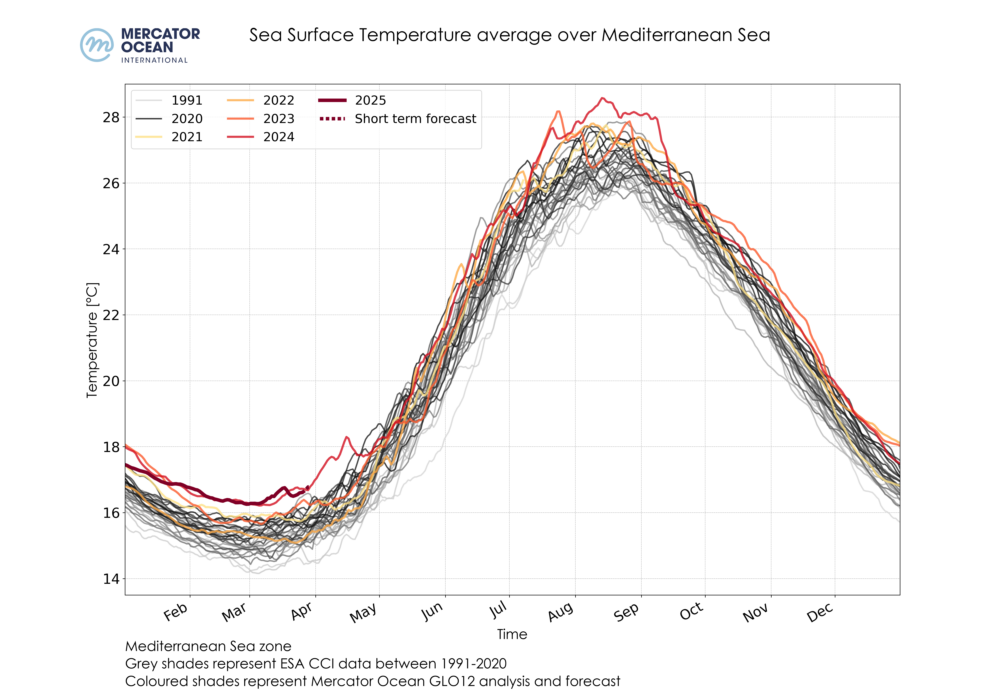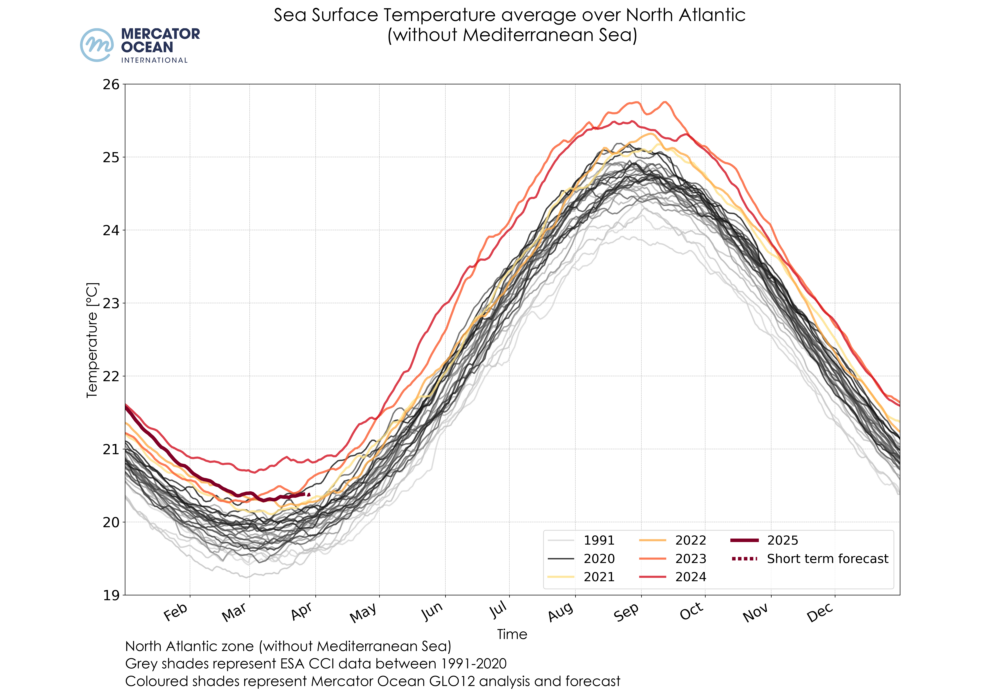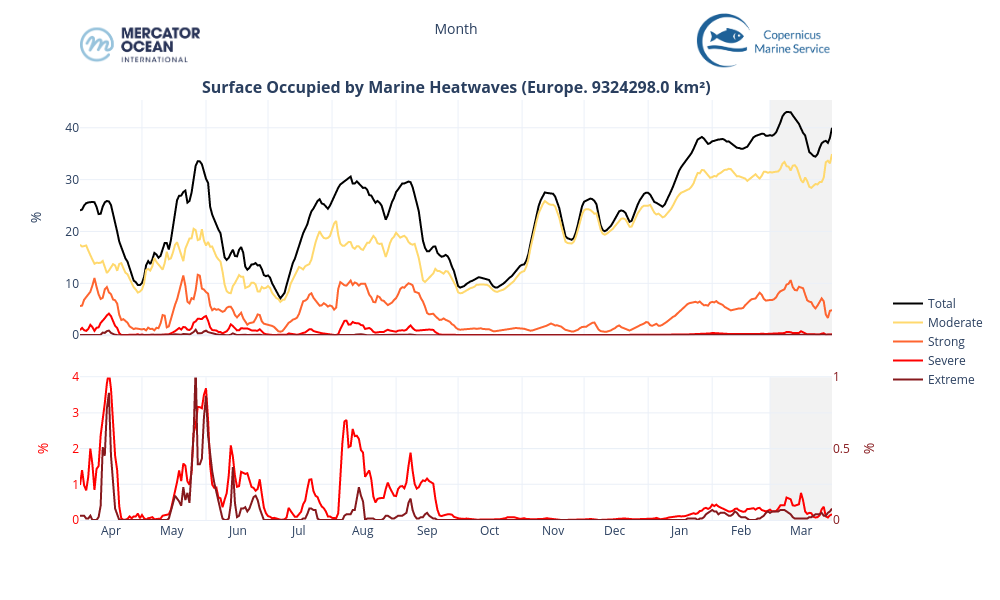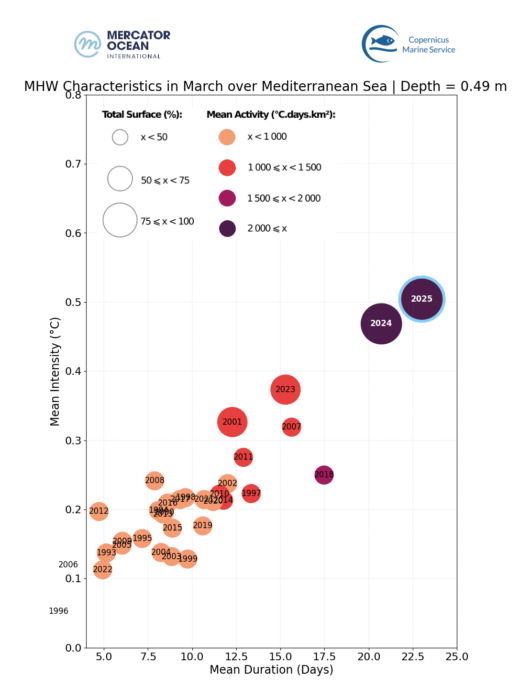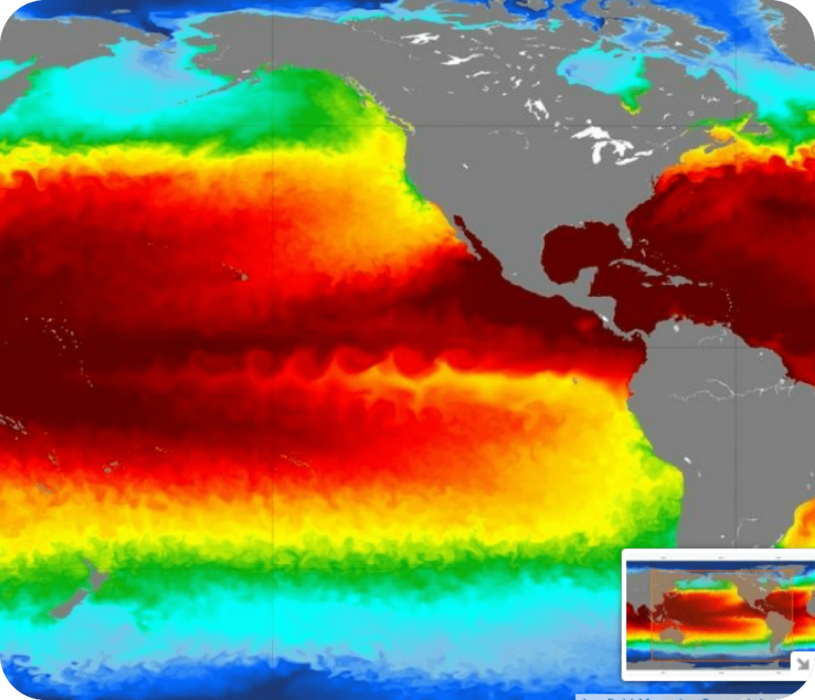A monthly reporting on mean sea surface temperatures and marine heatwave conditions.
Key takeaways
- In the past month, sea surface temperatures were on average 21.02°C in the global ocean. It was the second warmest March for the ocean since 1991.
- In the Mediterranean Sea, March 2025 was the warmest March, with a mean sea surface temperature of 16.44 °C.
- Marine heatwaves in the Mediterranean Sea were the longest and with the highest intensity for any month of March.
Sea Surface Temperature
Figure 1: Daily sea surface temperatures (SST) averaged for the global ocean (top), the Mediterranean Sea (left) and the North Atlantic Ocean (right) between 1991-2020 using ESA’s Climate Change Initiative (grey shades), and between 2021-2025 (colored shades) using Mercator Ocean International’s GLO12 analysis and forecast.
- March 2025 was the 2nd warmest March on record (after 2024), with a mean Sea Surface Temperature (SST) of 21.02 ± 0.06 °C (against 21.14 ± 0.07 °C in 2024).
- For the Mediterranean Sea, it was the warmest March month with a mean sea surface temperature of 16.44 ± 0.11°C.
- For the North Atlantic region, March 2025 was the 4th warmest March month (after 2020, 2023 and 2024) with mean sea surface temperature of 20.32 ± 0.08 °C.
Sea Surface Temperature Anomalies
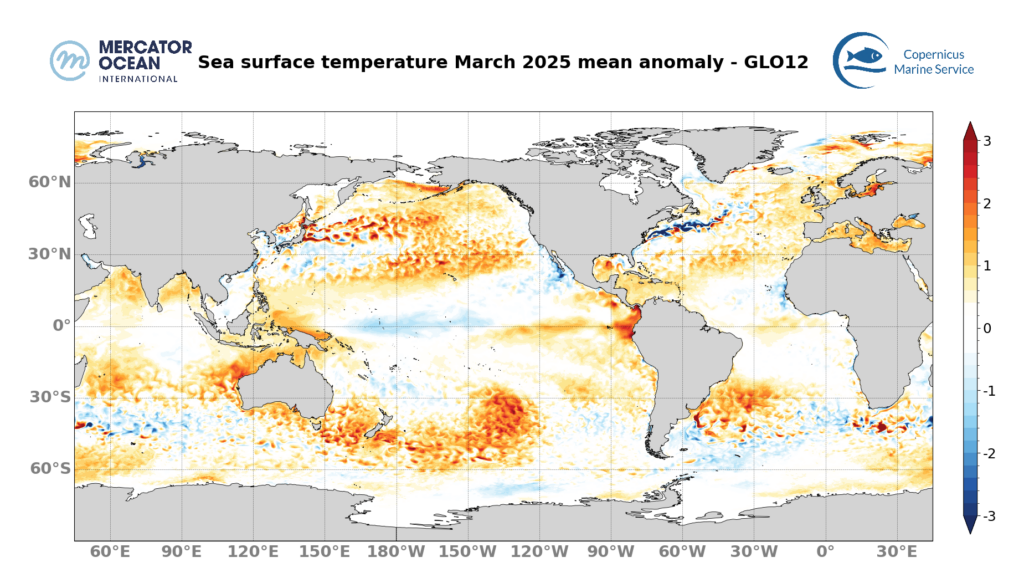
Sea surface temperatures (SSTs) were above average (1993-2022) in large parts of the ocean (Figure 2):
- The monthly mean for the entire Mediterranean Sea were above average.
- The Pacific Ocean shows strong SSTs at midlatitude in both hemispheres, reaching 3°C above average. In the east equatorial part, sea surface temperatures were above average but less intense.
- In the Atlantic Ocean , SSTs are predominantly above average, with particularly high values off the southern Brazilian coast.
- In the Indian Ocean, the largest values are present in the eastern part, near Australia.
Note: In the central Pacific, below average SSTs are still present along the equator but are less intense and widespread than in previous months.
Ongoing marine heatwaves: 31 March 2025
Long warming events may induce important stress on marine ecosystems *. Here is represented the ongoing marine heatwave (MHW) events at 31 March, and their onset time.
- 24% of the global ocean (between 60°S and 60°N) was affected by MHWs on the 31st of March.
- The majority of these MHWs developed recently, with 17% of the global Ocean (between 60°S and 60°N) affected by MHWs less than 1 month old.
- 5% of the global ocean on the 31st March was affected by events between 1-and 2-month-old.
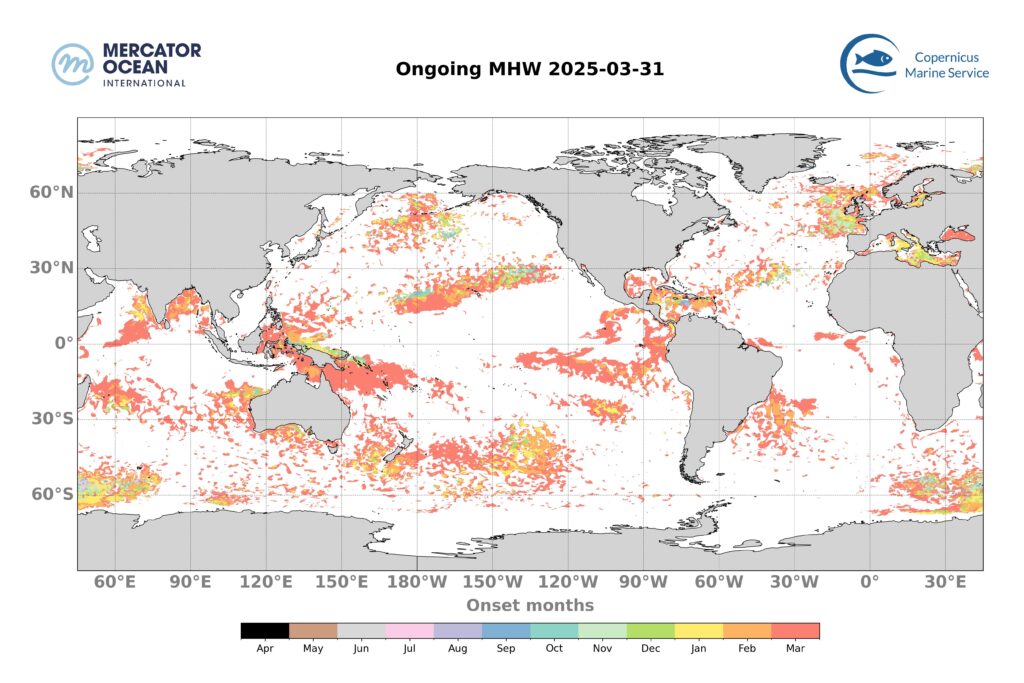
*Marine heatwaves (MHW) are extreme rises in ocean temperature for an extended period of time. They can occur at different locations in the ocean, and their magnitude and frequency have increased over the last couple of decades, with harmful impacts on ecosystems, and human activities. According to the latest report released by the Intergovernmental Panel on Climate Change (IPCC AR6 SYR), it is found with high confidence that in the near-term at 1.5°C global warming, the increasing frequency of marine heatwaves will increase risks of biodiversity loss in the oceans, including from mass mortality events (IPCC AR6 SYR).
Total surface exposed to marine heatwaves: April 2024 – March 2025
We monitor daily the surface occupied by MHWs and show for the past year (since April 2024) the proportion of the global Ocean (between 60°S and 60°N) exposed to MHWs. We focus on the evolution over the past March 2025 (grey bar).
Global Ocean
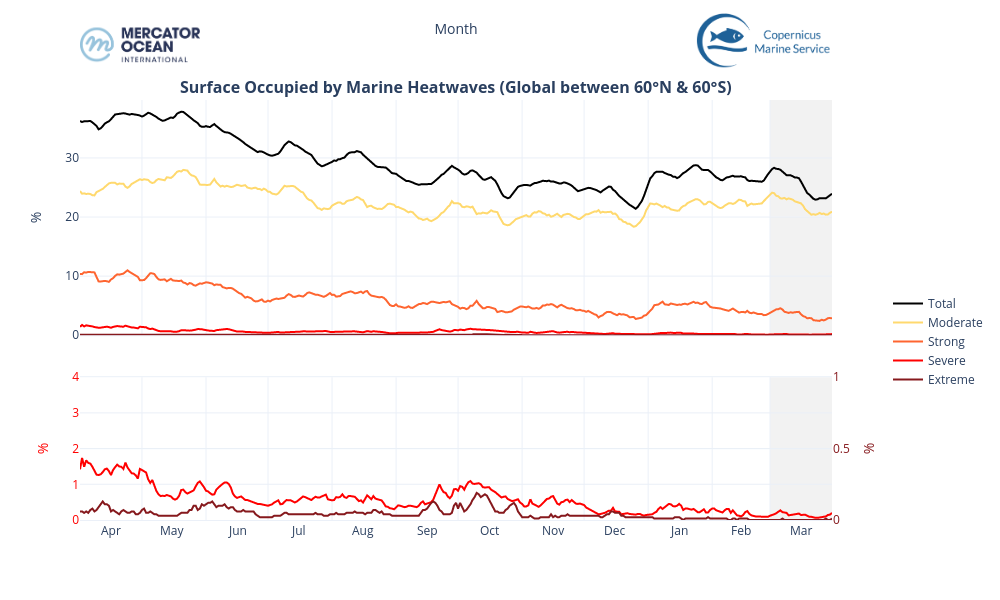
- In March, the total surface occupied by MHWs (black line) decreased from 28% to 24% – mostly of moderate and strong events (from 24% to 21% and from 4% to 3%, respectively). For comparison, in March 2024, MHW total extent represented ~35% of the global ocean (between 60°S and 60°N), with ~10% of strong category (not shown).
European Zone
For the ocean region of Europe including the Mediterranean Sea and the North Atlantic eastern coast (see figure 3) :
- The total MHW surface fluctuated around 39% – the largest monthly extent for 2025 so far. With a peak at 43% in the second week of March, MHWs were mostly composed of moderate and strong categories.
- Overall decrease in surface occupied by MHWs of strong category (from 7% to 5%). For comparison, in March 2024, the total MHW extent was ~25% with a peak at 34% (not shown).
Total number of marine heatwave days in March 2025
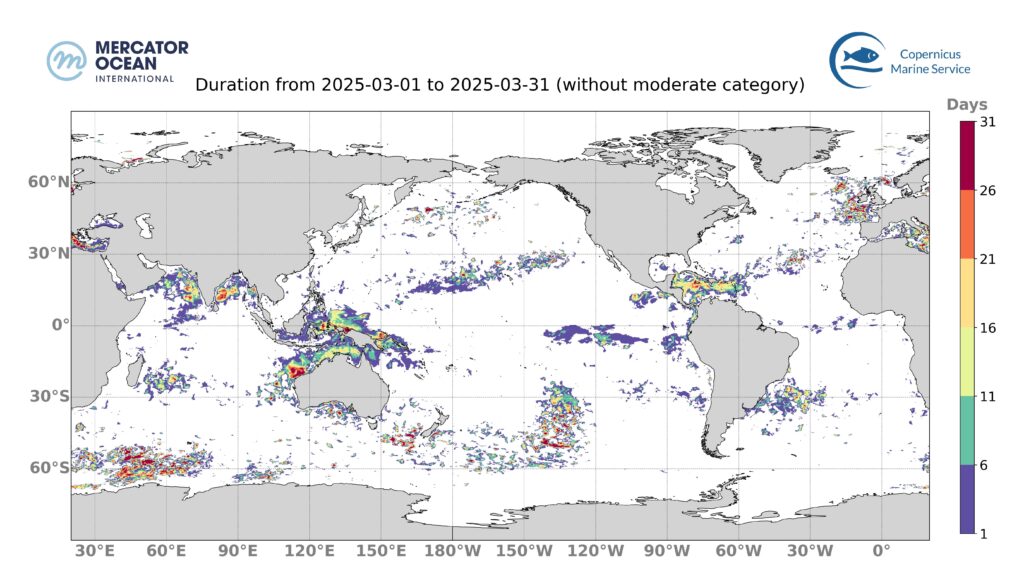
15% of the surface of the ocean is impacted by strong, or higher, MHW conditions for at least 1 day.
The southeast Asia region, north Australia, the Carribean sea and the southern Pacific between 120°W and 150°W are the most affected.
Figure 6: Number of days during which a MHW of category strong, severe or extreme occurred in February 2025. Blank areas mean that no MHW of strong or higher category happened during the month.
March Statistics
Figure 7: MHW characteristics all March months between 1993 and 2025. Duration, intensity, extent and activity averaged for each March month between 1993 and 2025 for the global ocean (left), for the Mediterranean Sea (centre) and the North Atlantic Ocean (right). March 2025 is highlighted with a blue edge.
The MHW statistics (duration, intensity, surface occupied and activity) for March 2025 are compared to those for March months from previous years since 1993.
- March 2025 is the 3rd most extreme March month in terms of duration (after 2016 and 2024) and intensity (after 2023 and 2024).
- In the Mediterranean Sea, March 2025 was the most extreme March in terms of MHW, breaking the record of 2024.
- In the North Atlantic, March 2025 was moderate in terms of MHW intensity. In terms of duration, it fared as the 3rd most extreme March month after 2010 and 2024 (close to 2005).
About the bulletin
Mercator Ocean International (MOi) publishes a monthly sea surface temperature bulletin reporting on mean temperature and marine heatwave conditions for the month just passed. It includes:
- Regions where MHWs are present and the time these events started,
- Timeseries showing the total surface occupied by MHWs globally and for the European region,
- The total number of days of exposure to MHW during the month (including only strong and higher intensity categories).
Image citation: European Union, Copernicus Marine Service Data 2025 I © Mercator Ocean
All images in this article can be used freely and should be cited with the information above.
Datasets and Products
Sea Surface Temperature
The results are obtained using the Copernicus Marine Service global analysis and forecasting system together with observation-based products.
- GLOBAL_ANALYSISFORECAST_PHY_001_024 Global Ocean Physics Analysis and Forecast sea surface temperature. E.U. Copernicus Marine Service Information. Marine Data Store (MDS). DOI: https://doi.org/10.48670/moi-00016
- ESA SST CCI reprocessed sea surface temperature analyses. E.U. Copernicus Marine Service Information. Marine Data Store (MDS). DOI: https://doi.org/10.48670/moi-00169
- NOAA OI SST V2 High Resolution Dataset data provided by the NOAA PSL, Boulder, Colorado, USA, from their website at https://psl.noaa.gov, Huang, B., C. Liu, V. Banzon, E. Freeman, G. Graham, B. Hankins, T. Smith, and H.-M. Zhang, 2021:
- Improvements of the Daily Optimum Interpolation Sea Surface Temperature (DOISST) Version 2.1, Journal of Climate, 34, 2923-2939. doi: 10.1175/JCLI-D-20-0166.1
- Global Ocean OSTIA Sea Surface Temperature and Sea Ice Analysis. E.U. Copernicus Marine Service Information. Marine Data Store (MDS). DOI: https://doi.org/10.48670/moi-00165
- ODYSSEA Global Sea Surface Temperature Gridded Level 4 Daily Multi-Sensor Observations. E.U. Copernicus Marine Service Information. Marine Data Store (MDS). DOI: https://doi.org/10.48670/moi-00016
Notes: The global analysis system was used to study the ocean surface temperature from 2021 and 2025. To study surface temperature for previous years (1991 to 2020), it was used the ESA CCI data. The other observation-based sea surface temperature products (OSTIA, OI SST and Odyssea) were used for calculating monthly mean and uncertainty values for February 2025.
Marine Heatwaves
The results are obtained using the Copernicus Marine Service global systems including the analysis and forecasting system together with the reanalysis product.
- GLOBAL_ANALYSISFORECAST_PHY_001_024 Global Ocean Physics Analysis and Forecast sea surface temperature. E.U. Copernicus Marine Service Information (CMEMS). Marine Data Store (MDS). DOI: https://doi.org/10.48670/moi-00016
- GLOBAL_MULTIYEAR_PHY_001_030 Global Ocean Physics Reanalysis sea surface temperature. E.U. Copernicus Marine Service Information (CMEMS). Marine Data Store (MDS). DOI: https://doi.org/10.48670/moi-00021
Notes: The global analysis system was used to study MHWs for 2024 and 2025. To study MHWs for previous Februarys (1993 to 2023), it was used the reanalysis system. The reanalysis product was used for generating a daily climatology using the 30-year period from 1993 to 2022.

